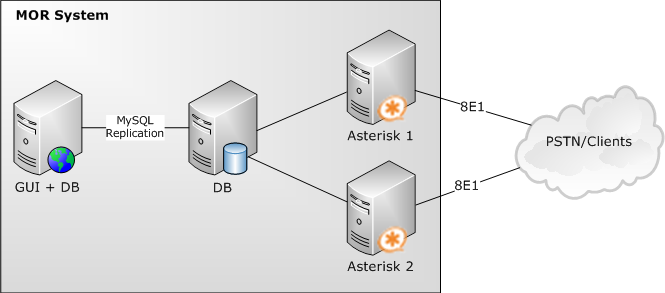Difference between revisions of "Implementations"
From Kolmisoft Wiki
Jump to navigationJump to search
| Line 10: | Line 10: | ||
* Such system is in Italy serving Call Shops | * Such system is in Italy serving Call Shops | ||
* E1 hardware is 2 x Sangoma A108DE cards | * E1 hardware is 2 x [http://www.sangoma.com/datasheets/a108-specs Sangoma A108DE] cards | ||
* This implementation is used for high volume calls to/from PSTN network over 16 E1 links were 4+4 E1 is for incoming and 4+4 E1 is for outgoing (on Asterisk 1 server 4 incoming/4 outgoing and same on server Asterisk 2). | * This implementation is used for high volume calls to/from PSTN network over 16 E1 links were 4+4 E1 is for incoming and 4+4 E1 is for outgoing (on Asterisk 1 server 4 incoming/4 outgoing and same on server Asterisk 2). | ||
* Separate server is dedicated to database which minimizes load on Asterisk servers. | * Separate server is dedicated to database which minimizes load on Asterisk servers. | ||
* GUI is on separate server with it's own DB connected to main DB server over MySQL Replication. | * GUI is on separate server with it's own DB connected to main DB server over MySQL Replication. | ||
Revision as of 20:11, 23 February 2008
This page shows some ways how MOR billing system can be used. Examples are from real implementations.
 4 server solution in Italy with 16 E1
4 server solution in Italy with 16 E1
- Such system is in Italy serving Call Shops
- E1 hardware is 2 x Sangoma A108DE cards
- This implementation is used for high volume calls to/from PSTN network over 16 E1 links were 4+4 E1 is for incoming and 4+4 E1 is for outgoing (on Asterisk 1 server 4 incoming/4 outgoing and same on server Asterisk 2).
- Separate server is dedicated to database which minimizes load on Asterisk servers.
- GUI is on separate server with it's own DB connected to main DB server over MySQL Replication.

